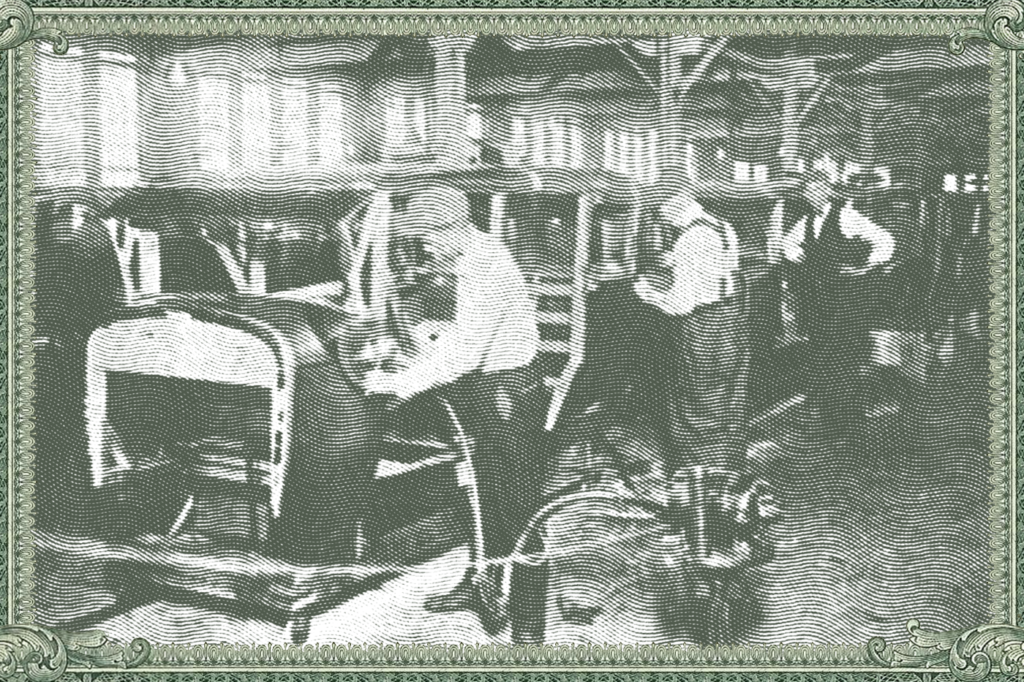Editors’ Note: Clara Piano’s essay is the third in our series, Reimagining Wealth. This series critically examines modern notions about wealth, the cross-generational practices surrounding wealth and property, and the interplay between wealth and family formation. Dr. Piano’s essay explains why family life and wealth are no longer bedfellows and ways that entrepreneurial strategies can remedy this situation. Yesterday, we published Jeffrey Polet’s essay about the way our cash economy liquidates social structures. Tomorrow, we will run an essay written by Patrick Brown on wealth and family policy.
On Monday, December 12 at 12:00pm ET, we will have a webinar discussion via Zoom with all the authors. Register here.
You can free things from alien or accidental laws, but not from the laws of their own nature. You may, if you like, free a tiger from his bars; but do not free him from his stripes. Do not free a camel of the burden of his hump: you may be freeing him from being a camel.
—G. K. Chesterton, Orthodoxy
Start your day with Public Discourse
Sign up and get our daily essays sent straight to your inbox.
In 1950, nearly 80 percent of American households included at least one married couple. Since 2010, the majority of households are now unmarried, with the sharpest increase being households constituted by a single man or a single woman. This change hasn’t occurred because young adults cannot afford to get married sooner. Rather, they can afford not to.
In a world where men and women had very different opportunities available to them, marriage used to be the primary way to specialize and expand wealth. But as a greater number of Americans completed four years of college (jumping from about 5 million in 1950 to 85 million in 2021), largely enabled by federal funding, the rewards of market work increased for young men and women alike. Additionally, time-saving technology (such as microwavable meals) and contraceptive technology (like the Pill) enabled young adults to remain single for longer. Family could be shaped around career, but not as easily vice versa. As long as the unencumbered employee remains the standard in the workplace, marriage and children will feel like less of a viable option for young adults.
Today wealth and marriage are positively correlated, not because wealthy individuals are the only ones who can afford to get married, but because wealth increases the value of marriage. For a spouse who forgoes wages to care for children, marriage functions as collateral because the couple’s goods have to be split equally if they divorce. As unilateral divorce made marriage less secure an investment, high-value assets like homes provided insurance to those stay-at-home parents. But for couples that don’t have many shared assets, cohabitation is an easier route thanks to policies that have made out-of-wedlock fertility similar to marital fertility.
Today wealth and marriage are positively correlated, not because wealthy individuals are the only ones who can afford to get married, but because wealth increases the value of marriage.
As some of the financial benefits to marriage have eroded, it can be tempting to use policy to make family formation more attractive—especially since marriage benefits children and protects mental health. The rising median age at first marriage and first birth, however, largely arises from a mix of technological progress and revealed preference, which aren’t things that policies can reverse.
I don’t mean to suggest that it is smooth sailing for modern parents. Statistics like the fertility gap and excess childlessness indicate that there are real barriers preventing people from having the number of children they desire (or any at all). My hope for conservative family policy is that it will free American families from “alien or accidental laws,” while not freeing them from the burden of being a family. I have written before on some ways that policy currently harms families, but in this essay I want to focus on the burden of being a family in modern times, specifically as it relates to combining careers and children.
I first summarize how economists think about the family and provide an overview of the main reasons why marriage and fertility are delayed. Next, I discuss some entrepreneurial solutions to the problems facing parents, focusing on increasing the complementarity between career and family. Finally, I argue that there are significant costs to a more interventionist approach to pro-family policy. Better solutions come from civil society, where entrepreneurs work to find solutions to the everyday problems modern parents face as they try to combine career and family and religious communities help young adults order their priorities.
Why Families Form and Why They Don’t
The founder of family economics and Nobel laureate Gary Becker viewed the family as the ultimate producer in society. A family takes the goods and services produced by the market and transforms them into utility (happiness) for its members. This is referred to as “joint production,” since many goods in life (children, for instance) take more than one person to produce. Moreover, some goods in life are just better with other people (think of a good movie), which economists call the “joint consumption” benefit of families. What brings two specific people together to start a family is their complementarity—the fact that each person can specialize in his or her work and share the fruits of his or her labor with the other, creating a bigger “pie” of happiness than before. Finally, families spread risk. If one member loses his or her job or gets sick, the other members can assist until he or she is back on their feet. To summarize, families produce together, enjoy together, and burden one another.
Family life also comes at a cost. Economists have a holistic view of costs, paying attention not only to financial expenditures, but to the opportunity cost of a choice, which refers to the benefits sacrificed from the next best alternative. Simply put, the next best alternative to family life—singlehood, prestigious jobs, and expensive leisure activity—has gotten better in the past few decades.
Many economists trace these changes back to technological advances, such as dishwashing machines (saving time on home production), infant formula (giving mothers flexibility), and the rise of the service and knowledge economy (making market work more attractive). At the same time, redistributive programs like Social Security have also reduced the benefits to children in the economic sense: parents no longer have to plan their family life with their old age in mind.
From 1950 to 2010, women’s labor force participation rose from around 30 percent to nearly 70 percent. Women now make up more college graduates than men, and female relative earnings have risen by more than twenty percentage points. These are largely positive developments, and I have little doubt that the feminine genius has contributed irreplaceable things to society in the past decades. However, they have also meant that the opportunity cost of getting married, which restricts job choice, and of having children, which restricts working hours, is higher than ever before.
The next best alternative to family life—singlehood, prestigious jobs, and expensive leisure activity—has gotten better in the past few decades.
Entrepreneurial Solutions
Intellectuals and policymakers are not the only ones thinking about how to make life easier for American families. Thousands of entrepreneurs are hard at work finding solutions to the everyday problems faced by modern parents as they try to combine career and family. From lightweight travel strollers and baby carrier wraps to affordable baby monitors and healthy, shelf-stable snacks, countless innovations continue to lower the costs of raising children and allow parents to remain active in society (or, in my case, to type with two hands). Since dual career households are currently the norm and likely to remain so, these entrepreneurial solutions increase the willingness of parents to welcome children and thus contribute to a culture of life.
Sometimes it’s as simple as increasing the quality of information available to young women. I would argue that Emily Oster’s Expecting Better has done more to raise the American birthrate than any pro-family policy could. In this book, she interprets countless scientific studies, assuring women that they can still enjoy life during pregnancy (and coffee and wine in moderation), while not spending exorbitant amounts on interventions and supplements. Still better than Oster’s book are the organizations on campus that provide support for students who are also parents. For example, Ave Maria University’s Campus Care transports expectant mothers to doctor appointments, provides babysitting during class times, and throws baby showers. The Catholic University of America also just expanded support for parents in their community, including—my personal favorite—changing tables in men’s bathrooms.
Why do I think these innovations work? They lower the opportunity costs of fertility for the woman at the margin—the one who is undecided about whether or not she will have a(nother) child. As ordinary people solve ordinary problems, they contribute to a world where parents can pursue their vocations in family and work together, while not changing the essential fact that families bear each other’s burdens. In a recent essay, Erika Bachiochi makes an eloquent case for the reunification of work life with family life. While she and I may disagree over the usefulness of specific policy proposals, I wholeheartedly agree that there is unfinished business when it comes to the acceptance of women (and their babies) into public life. Moreover, parenthood and economic growth are not at odds. Accommodating parents today can unleash untold economic productivity in the coming generations, since the ultimate economic resource is the creative human mind.
Technological solutions can only go so far, however, since the other side of the equation is preferences. Much can be done if parents have the courage to act on their convictions (for example, sacrificing career opportunities to locate near family). Additionally, two organizations (the Austin Institute and the Belmont House) that recently invited me to give a talk also made it clear that my young daughter and husband were welcome to come as well, offering a number of thoughtful accommodations. Would that every conservative organization practice what it preaches!
As ordinary people solve ordinary problems, they contribute to a world where parents can pursue their vocations in family and work together, while not changing the essential fact that families bear each other’s burdens.
Unintended Consequences of Intervention
As a young mother, I understand the appeal of many recent pro-family policy proposals. What could be wrong with giving parents some extra cash, especially when these programs are designed to be budget neutral? From the economic and historical perspective, however, there are unseen costs and unintended consequences to tinkering with the institution of the family. Being a family will always come with burdens. Above all, I fear that interventionist pro-family policy will replace the family as it tries to rescue it.
First, we should be honest about what these “pro-family” policies actually do. Child tax credits or allowances function as subsidies to home production. By way of the government, this is a simple transfer of resources away from those who will never have children toward those who will (or do) have children. The government then steps into the role of direct provider, one that is traditionally assigned to the parents.
Second and relatedly, government money never comes without strings (just ask the schools and universities). This may not be a problem while conservatives are in power, but what happens when government wants to incentivize controversial vaccinations or disincentivize homeschooling? Furthermore, pro-family policies also require that the government have a working definition of “family.” This is no small feat: do divorced couples receive these benefits? How would single mothers fare? What about same-sex couples with children? The recent history of debates over the definition of marriage seems to be a lesson in this regard.
Third, the full cost of such a program also needs to be accounted for. There is the opportunity cost of the redistributed resources that could have been put toward other purposes, as well as the costs of implementation (bureaucracy is not cheap!). One glaringly obvious issue is the federal debt, which will certainly harm future generations’ prospects for wealth—including our own children and grandchildren—as we refuse to practice the fiscal responsibility we preach to young Americans. As the Brookings Institution’s Isabel Sawhill put it: “We’re the grown-ups who should be taking care of America for future generations. Instead, we’re bequeathing a fiscal mess of biblical proportions.”
Finally, the idea of giving cash to families with children is far from new. Our own federal government piloted a now-forgotten program in the 1970s that would guarantee a minimum income to families with children—the Family Assistance Plan (FAP). Not only did the trials reveal reduced labor force participation rates for fathers and mothers, but it increased the chances of marital breakdown by 60 percent (compared to the control groups). As each new generation insists on learning, there are very good reasons for the traditional conservative approach to welfare: temporary and tied to work.
Entrepreneurial solutions can continue to help Americans combine career and family, but ultimately what is needed is a change of heart that puts family before career.
Religion and Family
The family is both a strong and delicate thing. It has outlasted every empire, but individual families can also break apart under the weight of ill-formed policies. If we truly believe the family is as important as we say, then it is crucial to proceed as if we are treading on holy ground—because we are.
Family life will always be a burden. I have argued that the risks of reducing these burdens through interventionist pro-family policy are greater than any potential benefits. Entrepreneurial solutions can continue to help Americans combine career and family, but ultimately what is needed is a change of heart that puts family before career. In a recent article, Catherine Pakaluk speaks to this point as she argues that religious liberty is the most pro-family policy a country can have. It is no coincidence that the United States has one of the highest birthrates of developed countries and is also the most religious by far. Faith helps us get our priorities straight and realize that our families matter more than our aspirations for a high-powered career.
I want to close on a note of gratitude. In many ways, it is the best time in history to be a parent. I gave birth to my daughter this summer, when infant mortality in the United States has never been lower, and there is a good chance that my husband and I will live to see our children’s children (what a blessing to contemplate!). We are all fortunate to live in a world where fewer parents have to watch their children starve each year, thanks to the wealth-creation of globalization. And perhaps surprisingly, there is solid evidence that the world is becoming more religious than ever. As John Paul II wrote, “Family, become what you are!”
Image designs by Jared Eckert.














